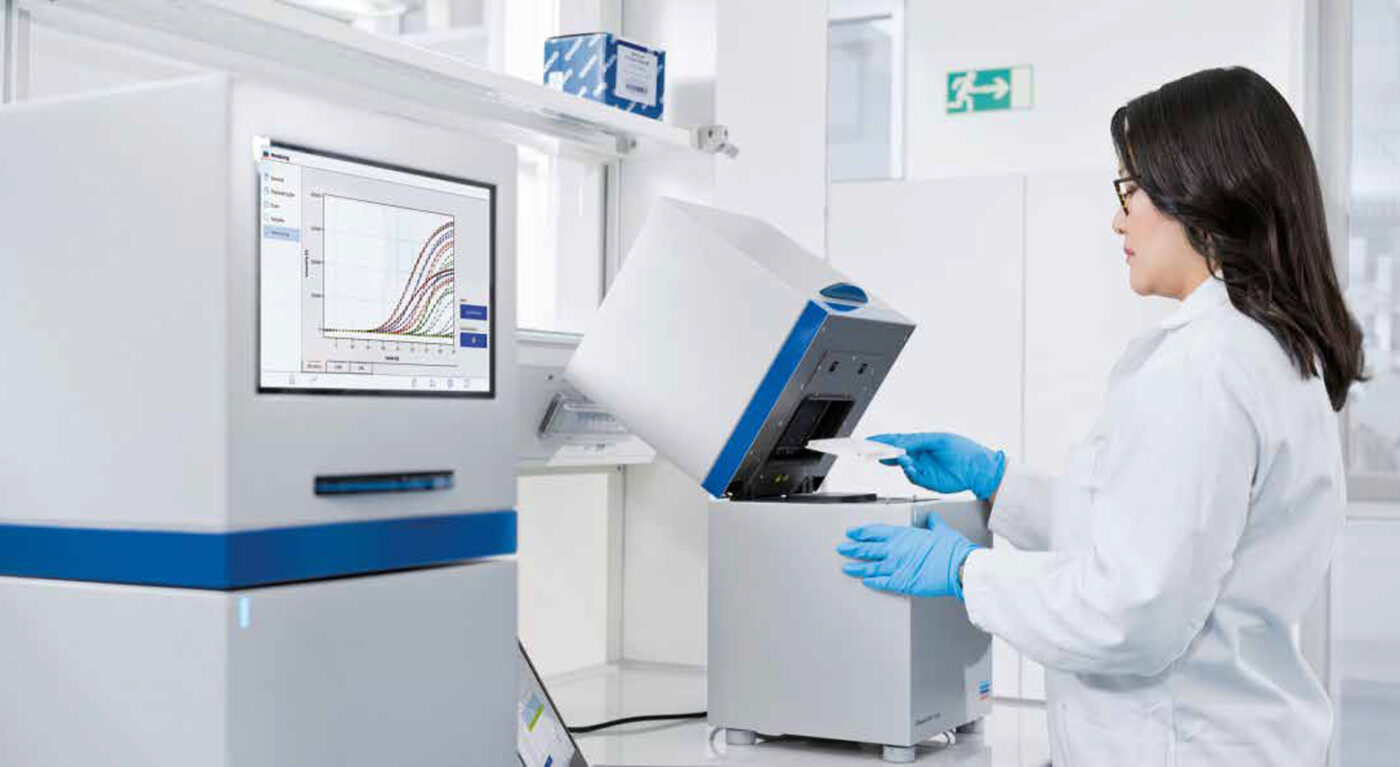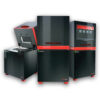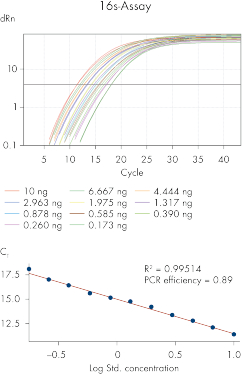The QIAquant qPCR instruments deliver on the fundamental expectations to combine high performance optical detection of qPCR products with a high performance thermal block. The result is an all-round versatile system for quantitative PCR applications such as expression analyses, genotyping and the detection of pathogens. The combination of high quality thermal elements, fast heating and cooling ramping rates and the fiber-optic shuttle system enables shorter cycling times down to less than 30 minutes for 40 cycles.
| 96-Well (2plex and 5plex) | 384-Well 5plex | |
|---|---|---|
| Format | Thermal block with 96 wells | Thermal block with 384 wells |
| Sample volume | 5–100 µl (10–80 µl recommended) | 2–30 µl (5–20 µl recommended) |
| Number of samples per run | 1 x 96-well microplate with optical film; 12 x 8-well strips 0.2 ml with optical lids; 96 x 0.2 ml individual vessels with optical lids | 1 x 384-well PCR plate with optical sealing film |
| Thermal performance | Range 4–99°C; control accuracy ±0.1°C | Range 4–99°C; control accuracy ±0.1°C |
| Temperature gradient | 40°C | 25°C |
| Maximum heating rate | max. 8°C/s, av. 7°C/s (depending on consumables used) | max. 4°C/s, av. 3.8°C/s (depending on consumables used) |
| Maximum cooling rate | max. 6°C/s, av. 5.5°C/s (depending on consumables used) | max. 2°C/s, av. 1.7°C/s (depending on consumables used) |
| Temperature uniformity (after 15 s) | ±0.15 °C at 55 °C ±0.25 °C at 72 °C ±0.50 °C at 95 °C | ±0.15 °C at 55 °C ±0.25 °C at 72 °C ±0.50 °C at 95 °C |
| Sensitivity | 1 nmol/l FAM at 30 µl sample volume in a 96-well PCR plate | 1 nmol/l FAM at 30 µl sample volume in a 384-well PCR plate |
| Measuring time | 96-well plate (single measurement, 5 colors) approximately 6 s | 384-well plate (single measurement, 5 colors) approximately 6 s |
Principle
| 96-Well 2plex | 96-Well 5plex | 384-Well 5plex | |
| Application | Real-time PCR | Real-time PCR | Real-time PCR |
| Multiplex capacity | 2 targets | 5 targets | 5 targets |
| Sample capacity | 96 samples | 96 samples | 384 samples |
| Control | Touchscreen and/or PC | Touchscreen and/or PC | PC |
Optics
The QIAquant instruments use a patented Fiber-Optic Shuttle System. Scanning just above the sample, the optic shuttle guarantees the homogeneous excitation of each individual sample and the reliable recording of the emitted fluorescent signals with high sensitivity and no cross-talk between wells. Composed of 5 different-colored long-life and high power LEDs, the light source guarantees the optimal excitation of known fluorescent dyes from blue to the near-infrared range and the emission signal is captured by a sensitive photomultiplier tube (PMT). The fiber-optic shuttle system is fitted with 8 individual light fibers in the QIAquant 96 instruments and 16 individual light fibers in the QIAquant 384 instrument. This enables fast read-out times of only 6 seconds for an entire plate regardless of the number of filters. The QIAquant instruments do not require the use of a reference dye such as ROX and do not need regular calibration.
Thermal performance
Accurate and homogeneous temperatures across the samples are critical for the rate and efficiency of PCR assays. The QIAquant instrument is fitted with high quality heating elements with gradient function and a temperature control precision of ± 0.1°C. The QIAquant 96 instruments are fitted with a sample block made of silver coated with gold. The sample block provides outstanding thermal properties in terms of temperature uniformity across the sample block down to ± 0.15°C at 55°C, and has an extremely fast heating and cooling rate up to 8°C/s. The uncompromising performance of the QIAquant ensures fast cycling and homogeneous heat distribution across all the wells of a plate. This ultimately means the highest possible reproducibility from well to well and from cycle to cycle.
Gradient function
The gradient function enables assay optimization and the easy determination of the optimal temperature for primer annealing which is crucial for efficient and specific target amplification. At any step in a protocol, you can program a temperature gradient with a span of up to 40°C across the reaction with 0.1°C steps. Instead of simply setting lower and upper limits, the Linear Gradient Tool (LGT) allows different integer temperature levels to be entered in relation to the calculated annealing temperature of the primers.
Motorized heated lid
The QIAquant motorized heated lid applies homogeneous pressure and the temperature can be adjusted from 30°C to 110°C.
Procedure
The QIAquant instruments enable quantitative real-time PCR in either intercalating dye or hydrolysis probe-based assays and in tubes, or in a 96- and 384-well plate format. QIAquant instruments are designed for convenience, ease of use and reliability, from run setup to interpretation of results. A QIAquant instrument will readily integrate in any new or existing real-time PCR workflow.
Flexibility of chemistries and plasticware
The QIAquant instruments work as an open system and can be used in combination with any compatible real-time PCR kits. SBS sample blocks make the QIAquant systems compatible with the majority of tubes, strips and low- or normal- profile plates, skirted, half-skirted or unskirted. For best performance, QIAGEN recommends the used of dedicated qPCR plates with white well plates and qPCR compatible foils or seals.
Multiplex PCR for co-detection of up to 5 different targets
The QIAquant instruments come with up to 5 color channels for multiplexing in real-time PCR applications. The QIAquant Software comes with built-in optimized generic cross-talk compensation. Users can create customized color compensation files for specific set of dyes if necessary.
| Channel | Excitation (nm) | Detection (nm) | Examples of fluorophores detected |
| Blue | 455±15 | 515±10 | FAM™, SYBR® Green, EvaGreen® |
| Green | 520±10 | 560±15 | JOE™, HEX™, VIC® |
| Orange (5plex versions only) | 580±15 | 620±15 | ROX™, Texas Red® |
| Red (5plex versions only) | 633±10 | 680±15 | Cy5®, Alexa Fluor® 647 |
| NIR 1 (5plex versions only) | 660±10 | 710±20 | Cy5.5®, Quasar® 705 |
Simple operation with the QIAquant software The QIAquant instruments are operated via the QIAquant software, using either the desktop version or the touchscreen version. This software is suitable for use by novice researchers, while maintaining the highly complex data analysis functions required by advanced researchers. The comprehensive software package supports all current state-of-the art real-time analysis procedures from basic to advanced algorithms. This provides complete freedom to analyze your valuable experimental data and increases the reliability of your results. Data security is assured and all process steps are trackable from starting the run to exporting the results. QIAquant Software is compatible with Audit trail for 21CFR part 11 compliance. Maintenance and hassle free The optical system of the QIAquant instrument involves individual illumination and detection of a sample with a PMT and use of a reference dye such as ROX is not required. The optical system does not need to be calibrated on a regular basis. The QIAquant instruments are factory-calibrated for optical and thermal accuracy. (QIAGEN does recommend yearly preventive maintenance.)
Applications
The QIAquant instruments are suitable for a broad range of PCR applications in molecular biology workflows. These include:
- Gene expression analysis
- Pathogen detection
- DNA methylation analysis
- Genotyping and gene scanning
- Validation of microarrays and NGS results

Block uniformity on the QIAquant 96 and QIAquant 384: Amplification curves (A) and melting curves (B) of respectively 96 and 384 replicates on QIAquant 96 and QIAquant 384.
Block uniformity on the QIAquant 96 and QIAquant 384: Amplification curves (A) and melting curves (B) of respectively 96 and 384 replicates on QIAquant 96 and QIAquant 384. Real-time PCR was done using 100 ng of E. coli DNA in each of the 96 and 384 block positions. (A) Amplification curves of a 300 bp amplicon of the 16S using QuantiNova SYBR® Green PCR Kit. (B) melting curve analysis of the amplicons. Low variation of Cq values (SD <0.2) and Tm of the melt curves (SD <0.1) demonstrate demonstrated temperature uniformity across the block of the QIAquant 96 and QIAquant 384.
10-log dynamic range of the QIAquant detection system: E. coli 16S was amplified from template concentration ranging from 10 fg to 7650 ng in 20 µl reaction volume, in duplicate.
Confident resolution of 1.5-fold dilutions on QIAquant 384: E. coli 16S was amplified from a 1.5-fold dilution series with template concentration ranging from 0.173 ng to 10 ng.
Specifications
| Features | Specifications |
| Dimensions | 59 cm x 27.5 cm x 27.5; when opened 70 cm x 27.5 cm x 50 cm |
| Weight | 30 kg |
| Voltage | 115 V, 230 V: 50/60 Hz |
| Power consumption | Max. 850 W |
| Noise level | 45 dB |
| Special feature | Heated lid with manual opening; automatic contact pressure 30 kg |
| Light source | Five high-intensity LEDs (blue, green, white, red, far-red) |
| What detected | Blue channel (455 nm/515 nm); Green channel (520 nm/560 nm); Orange channel (580 nm/620 nm) (on QIAquant 96 5plex and QIAquant 384 5plex only); Red channel (633 nm/680 nm) (on QIAquant 96 5plex and QIAquant 384 5plex only); NIR1 channel (660 nm/710 nm) (on QIAquant 96 5plex and QIAquant 384 5plex only) |
| Detection | Photomultiplier (PMT) |
| Connections | USB |
| Minimum computer requirements | Windows 10; Intel i3, >1 GHz; 1 GB RAM; HDD >300 MB; min. USB 2.0 |
| Software | Analysis: Absolute quantification, relative quantification, ΔΔCt method, allelic discrimination, efficiency calculation, DNA melting curves, POS/NEG analysis in the end point; Export: Excel, CSV, LIMS, GenEx, qBase |
Publications
FEATURES & BENEFITS
- Fast cycling protocol, down to 30 minutes for 40 cycles
- Multiplex detection of up to 5 different targets
- Temperature ramping rates up to 8°C/s
- Temperature uniformity down to ±0.15°C across the sample block
- Gradient function for assay optimization
PRODUCT DETAILS
You may place order by giving us a call
| Catalog Number | Description |
|---|---|
| QG9003000 | QIAquant 96 2plex 115V |
| QG9003010 | QIAquant 96 5plex 115V |
| QG9003020 | QIAquant 384 5plex 115V |













